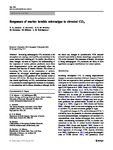Responses of marine benthic microalgae to elevated CO2
| dc.contributor.author | Johnson, VR | |
| dc.contributor.author | Brownlee, C | |
| dc.contributor.author | Rickaby, REM | |
| dc.contributor.author | Graziano, M | |
| dc.contributor.author | Milazzo, M | |
| dc.contributor.author | Hall-Spencer, Jason | |
| dc.date.accessioned | 2014-02-13T11:49:37Z | |
| dc.date.available | 2014-02-13T11:49:37Z | |
| dc.date.issued | 2013-08 | |
| dc.identifier.issn | 0025-3162 | |
| dc.identifier.issn | 1432-1793 | |
| dc.identifier.uri | http://hdl.handle.net/10026.1/2890 | |
| dc.description.abstract |
Increasing anthropogenic CO2 emissions to the atmosphere are causing a rise in pCO2 concentrations in the ocean surface and lowering pH. To predict the effects of these changes, we need to improve our understanding of the responses of marine primary producers since these drive biogeochemical cycles and profoundly affect the structure and function of benthic habitats. The effects of increasing CO2 levels on the colonisation of artificial substrata by microalgal assemblages (periphyton) were examined across a CO2 gradient off the volcanic island of Vulcano (NE Sicily). We show that periphyton communities altered significantly as CO2 concentrations increased. CO2 enrichment caused significant increases in chlorophyll a concentrations and in diatom abundance although we did not detect any changes in cyanobacteria. SEM analysis revealed major shifts in diatom assemblage composition as CO2 levels increased. The responses of benthic microalgae to rising anthropogenic CO2 emissions are likely to have significant ecological ramifications for coastal systems. © 2011 Springer-Verlag. | |
| dc.format.extent | 1813-1824 | |
| dc.language | en | |
| dc.language.iso | en | |
| dc.publisher | Springer Science and Business Media LLC | |
| dc.title | Responses of marine benthic microalgae to elevated CO2 | |
| dc.type | journal-article | |
| dc.type | Journal Article | |
| plymouth.author-url | https://www.webofscience.com/api/gateway?GWVersion=2&SrcApp=PARTNER_APP&SrcAuth=LinksAMR&KeyUT=WOS:000323066600005&DestLinkType=FullRecord&DestApp=ALL_WOS&UsrCustomerID=11bb513d99f797142bcfeffcc58ea008 | |
| plymouth.issue | 8 | |
| plymouth.volume | 160 | |
| plymouth.publication-status | Published | |
| plymouth.journal | Marine Biology | |
| dc.identifier.doi | 10.1007/s00227-011-1840-2 | |
| plymouth.organisational-group | /Plymouth | |
| plymouth.organisational-group | /Plymouth/Faculty of Science and Engineering | |
| plymouth.organisational-group | /Plymouth/Faculty of Science and Engineering/School of Biological and Marine Sciences | |
| plymouth.organisational-group | /Plymouth/PRIMaRE Publications | |
| plymouth.organisational-group | /Plymouth/REF 2021 Researchers by UoA | |
| plymouth.organisational-group | /Plymouth/REF 2021 Researchers by UoA/UoA07 Earth Systems and Environmental Sciences | |
| plymouth.organisational-group | /Plymouth/Research Groups | |
| plymouth.organisational-group | /Plymouth/Research Groups/Marine Institute | |
| plymouth.organisational-group | /Plymouth/Users by role | |
| plymouth.organisational-group | /Plymouth/Users by role/Academics | |
| dc.identifier.eissn | 1432-1793 | |
| dc.rights.embargoperiod | Not known | |
| rioxxterms.versionofrecord | 10.1007/s00227-011-1840-2 | |
| rioxxterms.licenseref.uri | http://www.rioxx.net/licenses/all-rights-reserved | |
| rioxxterms.type | Journal Article/Review |


